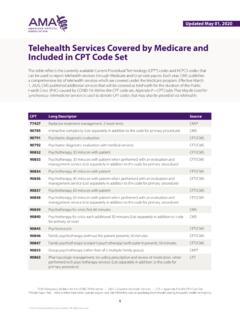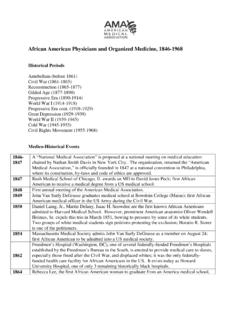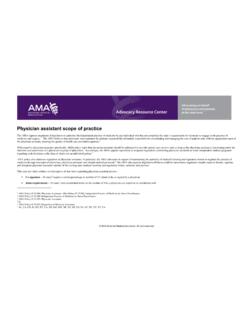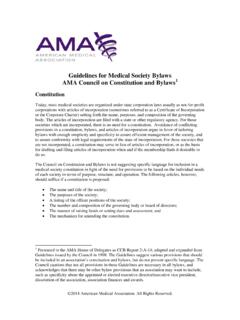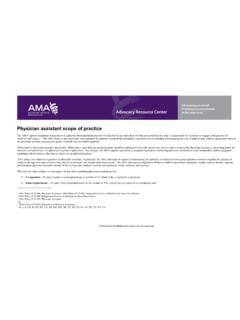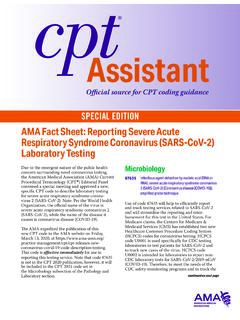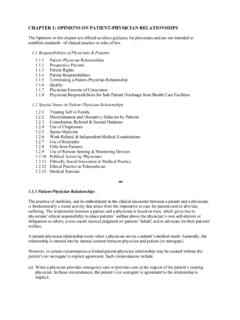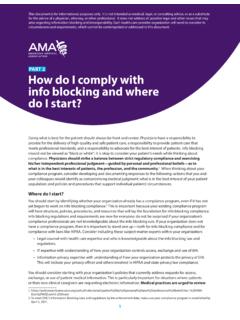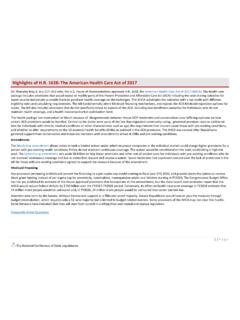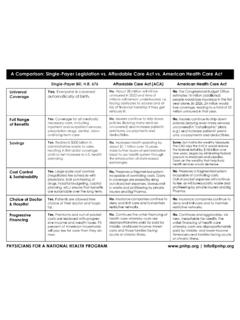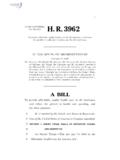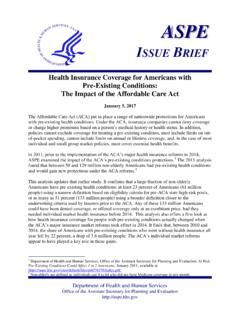Transcription of American Health Care Act - American Medical Association
1 American Health care Act Summary of Key Provisions, as passed by the House of Representatives on May 4, 2017 On May 4, 2017, the House of Representatives passed the American Health care Act (AHCA), 1628, legislation to repeal and replace several major provisions of the Affordable care Act (ACA). The bill was first introduced on March 6, and was subsequently amended several times before the floor vote. Below is a top-line summary of the key provisions in the legislation, as passed in the House. Effectively repeals both individual and employer mandates retroactively for years beginning with 2016 (by zeroing out the penalties); i ndividuals would no longer have to pay a tax penalty if they did not have Health insurance coverage ( , minimum essential coverage ). Imposes a late enrollment penalty of 30% of the premium, in lieu of the individual responsibility requirement, on individuals buying individual Health insurance coverage who have had a lapse in continuous creditable coverage for 63 consecutive days or longer during a 12-month look back period prior to the date of enrollment in new coverage.
2 The penalty is effective for special enrollments during the 2018 plan year (and lasts for remainder of the plan year) and for all other enrollments beginning with the 2019 plan year. Modifies ACA premium tax credits for 2018-2019 to increase amounts for young adults with income above 150% FPL and decrease amounts for adults 50 and older above that income level. o Tax credits cannot be used for plans that cover abortion. o Premium tax credits can be used to purchase catastrophic plans. o Premium tax credits can be used to purchase qualified Health plans ( , covering essential Health benefits) sold outside of the exchange, but are not advance-payable for such plans. Repeals ACA premium tax credits, beginning in 2020, and replaces them with advanceable, refundable flat tax credits adjusted for age. o Annual credit amounts begin at $2,000 up to age 29, and go up to $4,000 per individual age 60 and older. o Families can claim credits for up to 5 oldest members, up to a limit of $14,000 per year.
3 O Credits grow by CPI+1%, and eligibility phases out starting at income above $75,000 per year ($150,000 for joint filers); tax credit is reduced to zero at income of $95,000 for single individuals up to age 29, $115,000 for individuals 60 and older. o The credit can be applied to state-certified individual policies sold on or off the exchange. Policies that cover abortion are not eligible policies; abortions are covered when continuing the pregnancy will endanger the woman s life, or when the pregnancy results from rape or incest. o The federal government must establish a program for making advance payment of tax credits no later than January 1, 2020. Repeals cost-sharing subsidies, effective January 1, 2020, that help low-income individuals pay for out-of-pocket costs. Repeals standards for Health plan actuarial values ( , the metal levels). Modifies age-rating limit of 3:1 to allow 5:1 ratio, unless states adopt different ratios. Starting in 2018, states may apply for waivers to permit age rating ratios higher than 5:1.
4 Retains essential Health benefits requirement, but creates a state option to apply for waivers to redefine EHBs starting in 2020. 2017 American Medical Association . All rights reserved. Retains ban on Health status rating, but creates a state option to apply for waivers of the ACA community rating requirement, starting in 2019, for individual market applicants who have not maintained continuous coverage. In order to apply for community rating waiver, states must have established high-risk pools or reinsurance programs under the Patient and State Stability Fund (see below). Provides incentives for the use and expansion of Health savings accounts (HSAs), including increasing the annual tax-free contribution limit to equal the limit on out-of-pocket cost sharing under qualified high deductible Health plans ($6,550 for self-only coverage, $13,100 for family coverage in 2017, indexed for inflation). Additional catch up contribution of up to $1,000 may be made by persons over age 55.
5 Both spouses can make catch up contributions to the same HSA. Qualified Medical expense definition expanded to include over-the-counter medications and expenses incurred up to 60 days prior to date HSA was established. Tax penalty for HSA withdrawals used for non-qualified expenses is reduced from 20% to10%, effective January 1, 2017. Adds a Patient and State Stability Fund. States could use funds to provide financial help for high-risk individuals, to stabilize private insurance premiums and provide cost sharing subsidies, promote access to preventive services, for mental Health and substance use disorder services, for maternity coverage and newborn care , and for other purposes. In states that do not successfully apply for grants, funds will be used for a default reinsurance program, to be administered by the Centers for Medicare and Medicaid Services (CMS), which will pay 75% of claims between $50,000 and $350,000; starting in 2020, CMS Administrator can establish different reinsurance rate and claims thresholds.
6 Funding available includes: o $100 billion over 9 years ($15 billion per year for 2018-2019, $10 billion per year for 2020-2026) for grants to states or for default reinsurance program. o $15 billion over 9 years for a new Federal Invisible Risk Sharing Program to be administered by CMS for first two years and then by states beginning in 2020. o $8 billion over 5 years (2018-2023) for states that elect community rating waivers to provide financial assistance to people whose premiums are surcharged based on Health status under that waiver. o $15 billion for 2020 to be used solely for maternity coverage and newborn care and mental Health and substance use disorders. o Grants cannot be made to a state unless it agrees to make matching funds available. Repeals the small business tax credit program. Makes significant changes to the Medicaid program. o Limits enhanced FMAP for Medicaid expansion to states that adopted the expansion as of 3/1/17, and sunsets enhanced FMAP for those states as of 1/1/20 (except for beneficiaries who were enrolled through the expansion as of 12/31/19 who do not have a break in eligibility of more than one month).
7 Limits the expansion state enhanced match rate transition percentage to CY 2017 levels of 80% (instead of phasing up the match to equal the ACA enhanced match rate by 2020). o Converts federal Medicaid financing to a per capita cap beginning in FY 2020. Per enrollee caps for five enrollment groups , elderly blind and disabled, children, expansion adults, and other adults are based on 2016 expenditures divided by full-year equivalent enrollees in each category and trended forward to 2019 by Medical CPI (excludes administrative costs, disproportionate share hospital (DSH) payments, Medicare cost-sharing, and safety net provider payment adjustments in non-expansion states and certain categories of individuals, including the Children s Health Insurance Program (CHIP), those receiving services through Indian Health Service (IHS), those eligible for Breast and Cervical Cancer services). The target expenditures in 2020 are calculated based on the 2019 per enrollee amounts for each enrollment group adjusted for non-DSH supplemental payments and increased by an inflationary factor multiplied by the number of enrollees in each group.
8 In 2021 and beyond, 2017 American Medical Association . All rights reserved. per enrollee amounts are based on the prior year amounts increased by an inflationary factor. Beginning in FY2020, any state with spending higher than their specific target would receive reductions to their Medicaid funding for the following year. o In non-expansion states, repeals DSH cuts beginning in 2018, and provides $10 billion over 5 years for such states for safety net funding. For expansion states, DSH cuts would be repealed for FY2020-FY2025. o Provides states with the option, beginning FY2020 to select a block grant for their Medicaid program, which would be for a 10-year period. States could elect block grant for children and non-expansion adults or only for non-expansion adults and states could not set eligibility conditions (except that states must cover mandatory pregnant women and children and infants born to eligible pregnant women for 1 year, depending on the category elected).
9 O Add state option to require work as a condition of eligibility for nondisabled, nonelderly, non-pregnant Medicaid adults. Repeals ACA taxes starting in 2017, except for the Cadillac tax on high-cost employer-sponsored group Health plans, which would be suspended for tax years 2020 through 2025; repeals Medicare payroll tax (Hospital Insurance) on wages for high-wage individuals, effective January 1, 2023; . Prohibits federal Medicaid funding to Planned Parenthood clinics for one year beginning with the law s enactment. Eliminates the Prevention and Public Health Fund after 2018 and rescinds all remaining unobligated funds as of that date. 2017 American Medical Association . All rights reserved.
